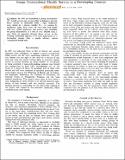Group Occupational Health Service in a Developing Country
| dc.contributor.author | H. De, Glanville | |
| dc.date.accessioned | 2021-11-09T12:02:58Z | |
| dc.date.available | 2021-11-09T12:02:58Z | |
| dc.date.issued | 1970 | |
| dc.identifier.uri | https://repository.amref.ac.ke/handle/123456789/346 | |
| dc.description.abstract | Summary: In 1967 an experiment of 11 group occupational health service was set up in Dar es Salaam to provide direct service to industrial firms. Target companies were visited by a doctor, smaller firm in rotation by auxiliaries. After three years 65 communities had joined with over 15,000 employees, and workers were attending the group dispensaries at a rate of over 250,000 visits a year. Such an approach through direct service to the the working community appears to be more appropriate to a developing country than a purely advisory central occupational health unit. | en_US |
| dc.language.iso | en | en_US |
| dc.publisher | British Medical Journal | en_US |
| dc.relation.ispartofseries | ;4, 548-550 | |
| dc.subject | Occupational health | en_US |
| dc.subject | Industrial | en_US |
| dc.subject | Working | en_US |
| dc.subject | Dar es Salaam | en_US |
| dc.subject | Tanganyika | en_US |
| dc.subject | Tanzania | en_US |
| dc.title | Group Occupational Health Service in a Developing Country | en_US |
| dc.type | Article, Journal | en_US |
Files in this item
This item appears in the following Collection(s)
-
General - GEN [367]
This is a collection of research papers from the wider Amref community

